By now you’ve seen tofu pop up a few times in my recipes. I thought you might like to know a bit more about it, and why it’s used so much for a vast array of things in the vegan foodie world.
For starters, tofu is made from soybeans. First the dried soybeans are processed into soy milk. Then a salt or acid-based coagulant is stirred into the milk, causing it to form curds from the protein. The curds are separated from the whey and then pressed into a mold. The resulting product is tofu, sometimes also called bean curd. It is a relatively high protein source, low in fat and a good substitute for meat or dairy in many dishes.
Tofu can be found in most grocery stores. Some carry many varieties. Depending on where you live, you may be able to find a large variety of tofu products. In an Asian market, the choices can be confusing, overwhelming, even. But, they basically all break down into two types: fresh tofu, or processed tofu.
Fresh tofu is the kind you will most commonly see and use. It is the type that is sold in sealed plastic tubs and looks like a block of cream cheese floating in water. Processed tofu is usually another product that has been made from fresh tofu.
The fresh tofu itself comes in about four common styles. Each of these refers to the amount of water that is in the tofu. The more water, the softer the tofu.
Silken fresh tofu is the softest, containing a large amount of water. It’s almost like tofu pudding. It’s most commonly used when you want something smooth and creamy. I use it to make vegan sweet cream, sour cream, vegenaise, other creamy salad dressings, and no-bake pies or custards.
You will sometimes see medium tofu in the store. It will have more density and less water than silken, but it will still be fairly soft. It can be used in place of things like cream cheese because it has a spreadable consistence. Depending on what you’re making, medium tofu can be used in place of silken.
Firm (also called Regular) tofu will look the most like a smooth block of cheese. It will have some tooth to it but still be soft, and normally slices fairly well, but must be handled with care. It is the most commonly used variety, and can be used with almost any cooking technique from frying to grilling.
Extra Firm tofu may also be referred to as pressed tofu. This type has the highest amount of calcium. Before the tofu is packaged high pressure is used to form a very dense block with a very cheese-like texture. It will hold up well to marinating and cooking on the grill.
Note: Unless I specifically state otherwise, when I refer to tofu in a recipe, I am referring to fresh tofu.
Fresh tofu is sold in a refrigerated section of the store. When you buy it, check the “use by” date stamped somewhere on the box. By the freshest tofu available, and try to use it by the date marked. It will keep in your refrigerator, unopened for a couple of weeks.
When you open it, look at the water, it should be clean, not slimy or have any kind of spots or mold. Smell it. It should have almost no smell at all, or just a fresh, clean scent. If it smells sour, discolored, or shows signs of mold, throw it away. It has spoiled.
If you open a tub of tofu, and you’re not going to use all of it, take it out of the original tub, and store the part you’re not using in a clean container covered with pure water. Change the water daily until you use the tofu. (It’s not hard. Put a post-it note on the refrigerator and write the date on it every time you change the water!)
When using firm/regular tofu, and you want to fry it, as in crispy tofu for example, you may want to press it. This process removes excess water, allowing marinades to be more readily absorbed. In addition, water and frying don’t mix well. So if the tofu has less water in it, and you’re not using the extra firm variety, pressing the tofu will help it fry better.
Pressing isn’t that hard, but you will need to allow 15 or 20 minutes. Do this right before you fry it. Here are the parts and tools needed.
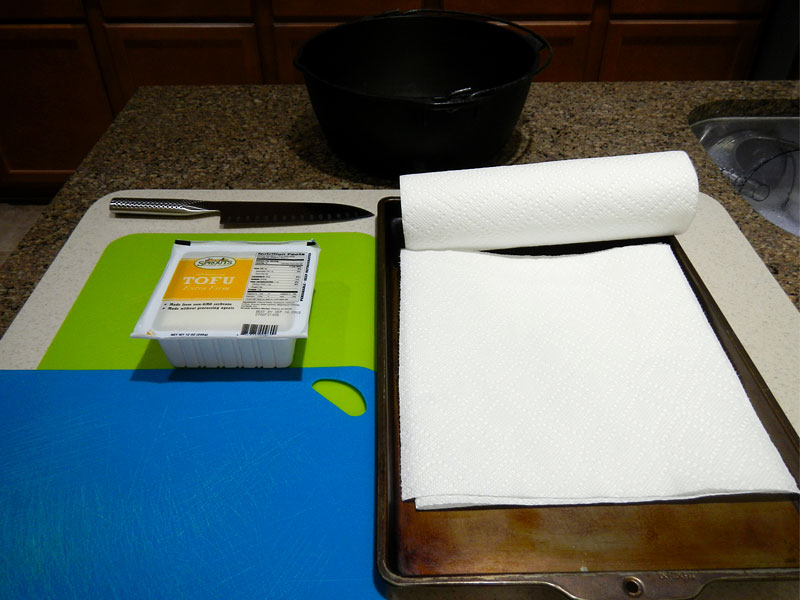
Note: Yes, this is actually extra firm tofu which doesn’t need to be pressed. But it’s what I was preparing when I took the pictures. The next time I press regular tofu I will update the images. The process is the same, though.
You can use any suitable flat surface to press the tofu on. I like to use something rimmed, so I don’t make a mess if I didn’t put down enough paper towels to absorb all the moisture. Place several sheets of paper towels in a stack to put the tofu on.
Remove the block of tofu from the package. Rinse it off in cold water. Pat dry on a paper towel and put it on a cutting board.
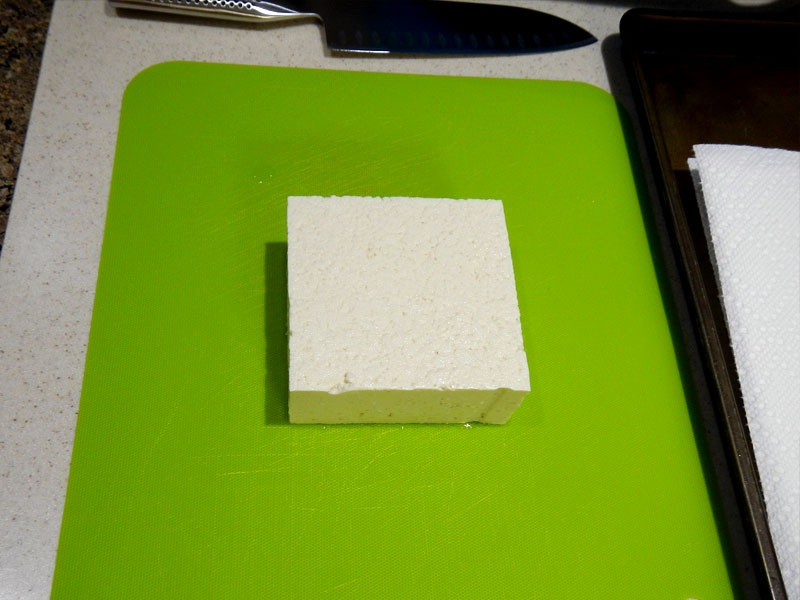
Cut the block of tofu in half.
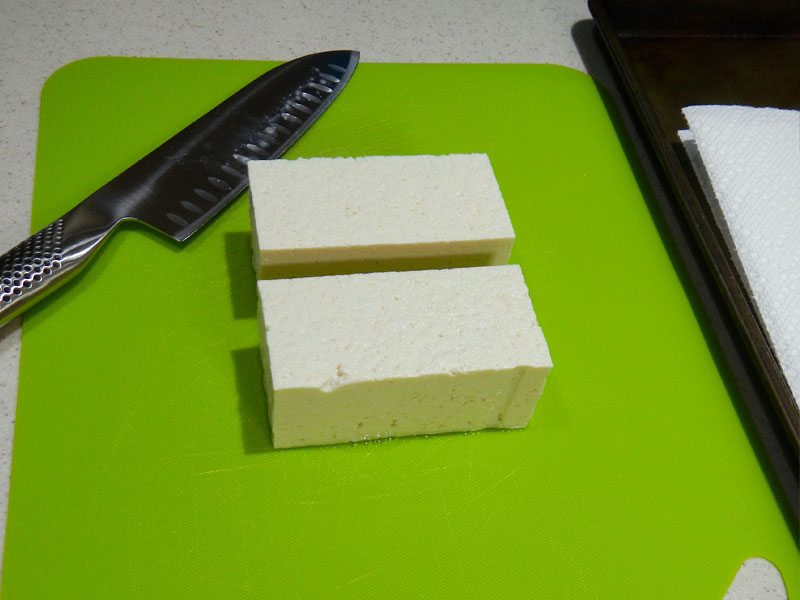
Cut each half in half again, horizontally.
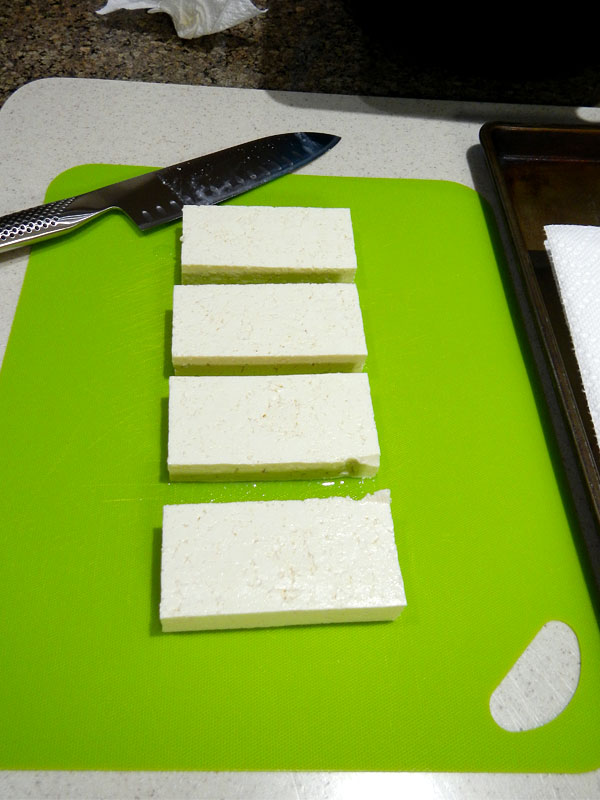
Place each of the pieces on the stack of paper towels with space in between them.
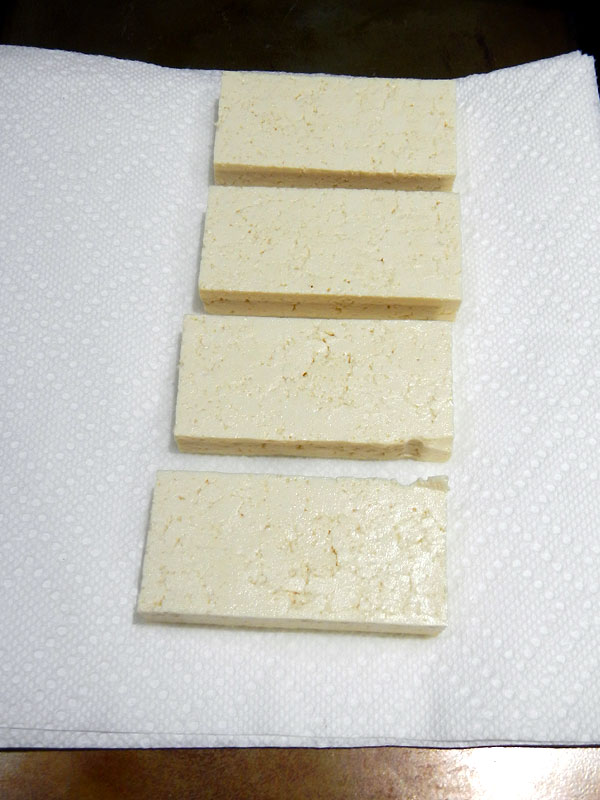
Cover with another stack of paper towels. You can tuck these in on the sides a bit if you like.
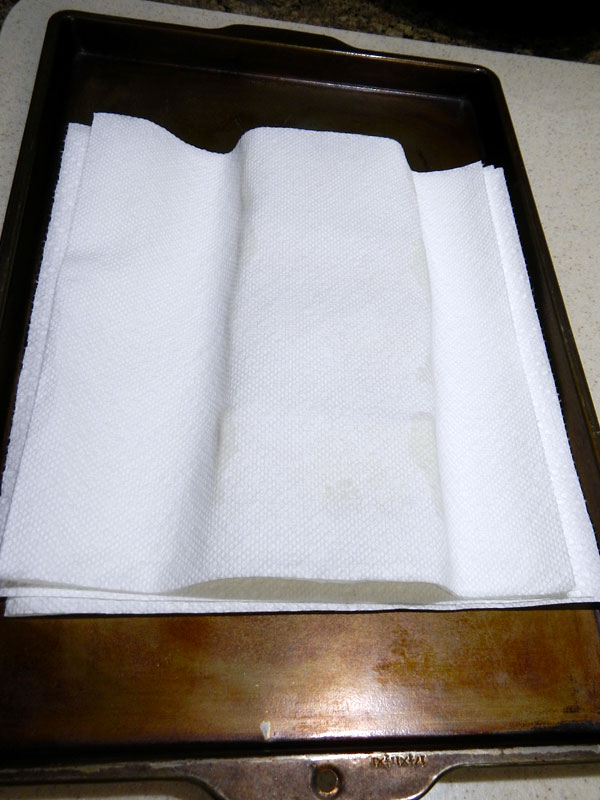
Next, I put another cutting board on top of the stack. It keeps the weight clean, and also helps distribute it more evenly.
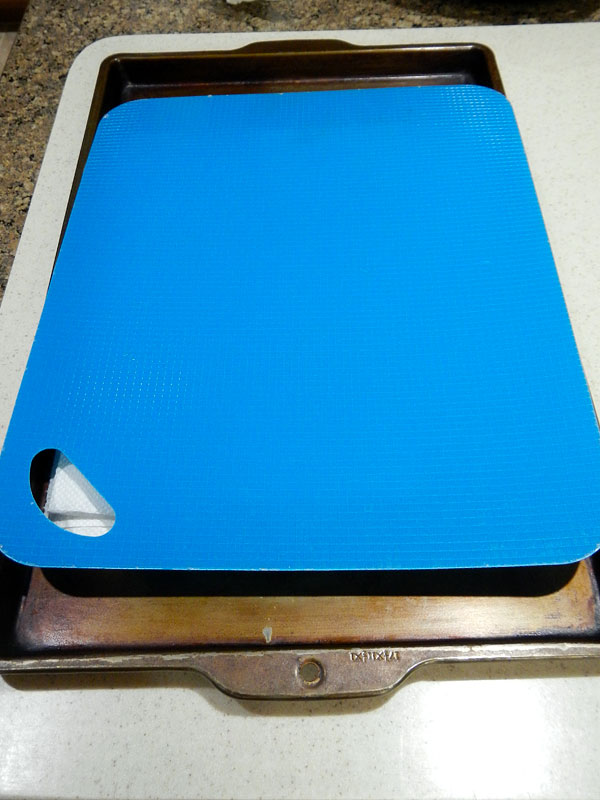
Add whatever weight you’re using to the mat. You need enough weight that you are pressing the tofu, but not smashing it. The slices should bulge a little bit on the sides, but not a lot. I’m using my cast iron dutch oven today because this is extra firm tofu to begin with. It will stand up to a lot of weight. I have used cook books, and even a salad bowl with an unopened bag of dried beans. A pie plate with cans in it will work, too.
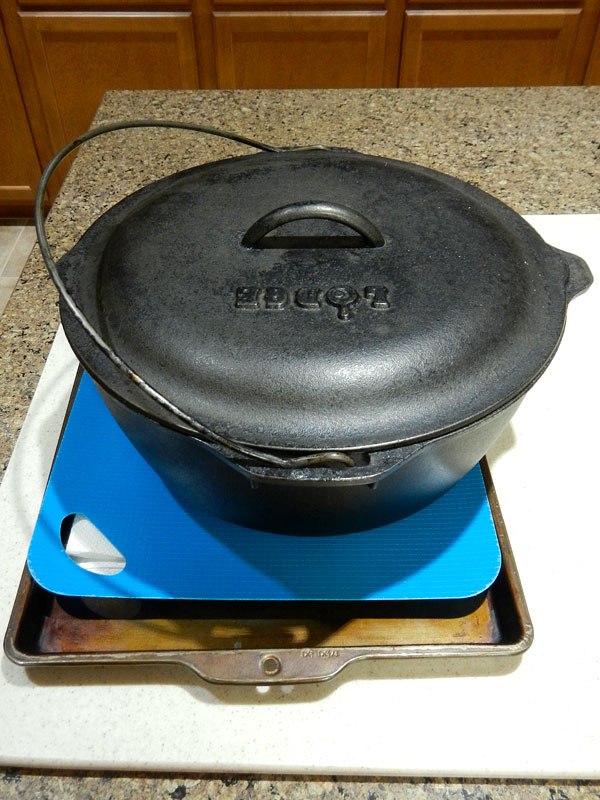
Set your timer for 20 minutes.
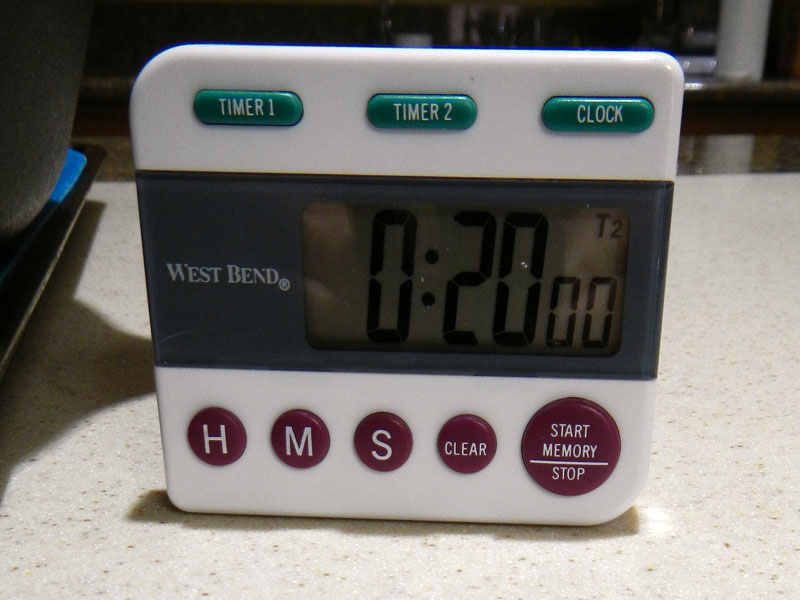
You can check it about half way, if you like. If the paper towels become sodden and water is puddling beyond them, you can change them for fresh as needed.
When the timer is done, you can remove the weights, mat and paper towels. Depending on how much water was in your tofu, and how pressed it now is, it should be less shiny, may have an imprint of the embossing design from the paper towel, and be flatter than when you started.
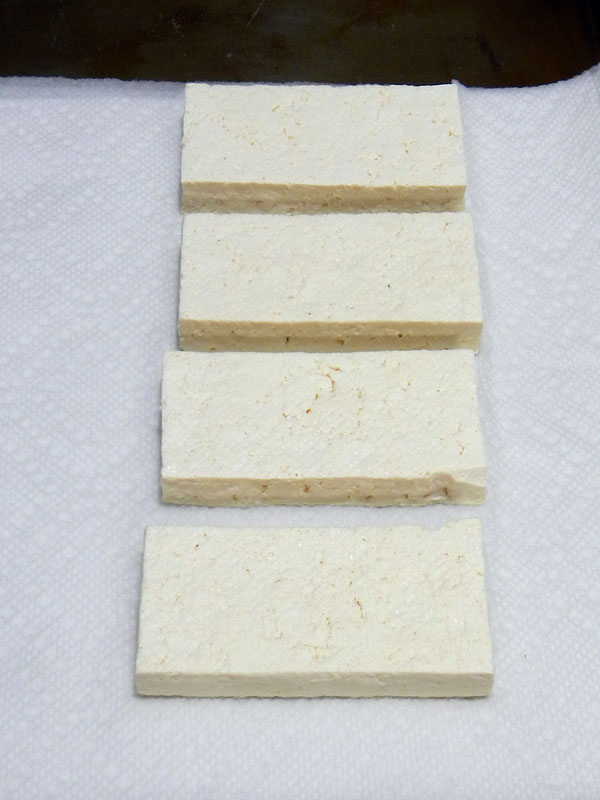
At this point, you could finish cutting it into 3⁄4 inch cubes and fry it to make crispy tofu or tofu croutons. It could be added to soups, stir fry, or baked in the oven.
Note: If you wish, you can press an entire block of tofu at one time. It may take a bit longer, though. Cutting it reduces the time.
Enjoy!